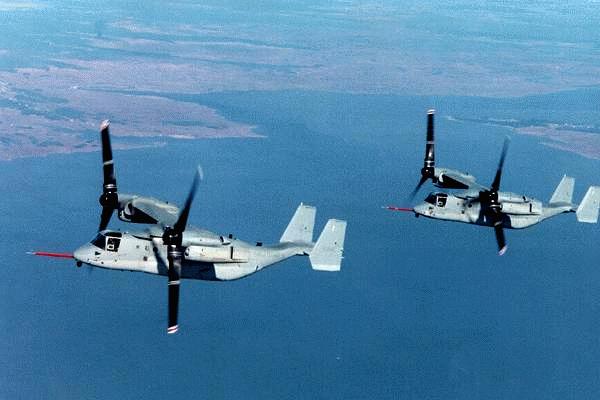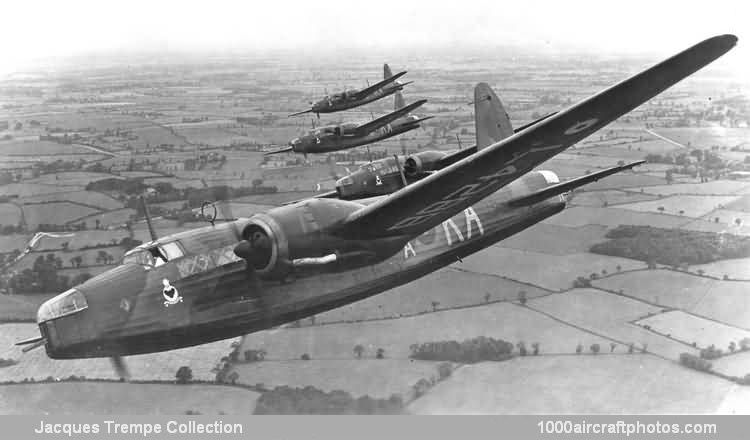V22 Osprey

The V-22 Osprey is an American joint service, medium lift, multi-mission tilt-rotor aircraft developed by Boeing and Bell Helicopters. The V-22 Osprey is powered by two Allison T406-AD-400 turboshafts which allow for vertical and short take-off and landing (V/STOL) with 24 combat equipped troops, dual-hook external loads up to 15000 lbs, cruise speeds in excess of 582 kmh, and a mission radius exceeding 200 nautical miles. The helicopter is self-deployable world wide with a ferry range over 3892 km. The normal operating range is up to 2224 km. The aircraft operates as a helicopter when taking off and landing vertically. The nacelles rotate 90 degrees forward once airborne, converting the aircraft into a turboprop aircraft. The aircraft can provide VTOL with a payload of 24 troops, or 6000 lbs of cargo at 430 nautical miles combat range, or VTOL with a payload of 8300 lbs of cargo for a range of 220 nautical miles. The tilt-rotor aircraft is available in three configurations for the US Joint Services Operational Requirements: the Combat Assault and Assault Support MV-22
for the US Marine Corps and the US Army, the long range Special Operations CV-22 for US Special Operations Command (US SOCOM) and the US Navy HV-22, for combat search and rescue, special warfare and fleet logistic support. The main cabin which measures 6 x 6 x 24 ft, is fitted with crash-resistant foldaway seats, arranged twelve on each side and inward facing, for 24 fully equipped troops. For the medical evacuation role the cabin can accommodate 12 litters (stretcher patients) and a team of medical officers. The cargo handling equipment includes a cargo winch and pulley rated at 2,000 lbs. Roller rails and shock absorbing cargo tie down rings are fitted on the cabin floor. The main door is on the right of the fuselage immediately behind the cockpit and a rear loading ramp door at the back of the fuselage is operated hydraulically with actuators.

The V-22 Osprey is an American joint service, medium lift, multi-mission tilt-rotor aircraft developed by Boeing and Bell Helicopters. The V-22 Osprey is powered by two Allison T406-AD-400 turboshafts which allow for vertical and short take-off and landing (V/STOL) with 24 combat equipped troops, dual-hook external loads up to 15000 lbs, cruise speeds in excess of 582 kmh, and a mission radius exceeding 200 nautical miles. The helicopter is self-deployable world wide with a ferry range over 3892 km. The normal operating range is up to 2224 km. The aircraft operates as a helicopter when taking off and landing vertically. The nacelles rotate 90 degrees forward once airborne, converting the aircraft into a turboprop aircraft. The aircraft can provide VTOL with a payload of 24 troops, or 6000 lbs of cargo at 430 nautical miles combat range, or VTOL with a payload of 8300 lbs of cargo for a range of 220 nautical miles. The tilt-rotor aircraft is available in three configurations for the US Joint Services Operational Requirements: the Combat Assault and Assault Support MV-22
for the US Marine Corps and the US Army, the long range Special Operations CV-22 for US Special Operations Command (US SOCOM) and the US Navy HV-22, for combat search and rescue, special warfare and fleet logistic support. The main cabin which measures 6 x 6 x 24 ft, is fitted with crash-resistant foldaway seats, arranged twelve on each side and inward facing, for 24 fully equipped troops. For the medical evacuation role the cabin can accommodate 12 litters (stretcher patients) and a team of medical officers. The cargo handling equipment includes a cargo winch and pulley rated at 2,000 lbs. Roller rails and shock absorbing cargo tie down rings are fitted on the cabin floor. The main door is on the right of the fuselage immediately behind the cockpit and a rear loading ramp door at the back of the fuselage is operated hydraulically with actuators.










